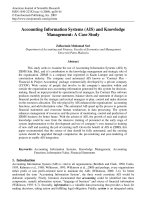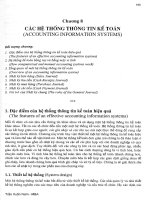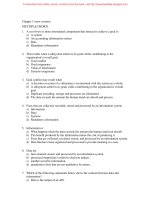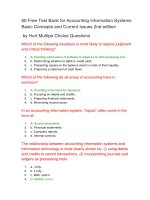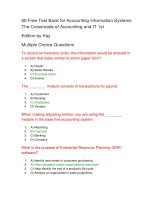Ebook Corporate accounting information systems Part 1
Bạn đang xem bản rút gọn của tài liệu. Xem và tải ngay bản đầy đủ của tài liệu tại đây (8.44 MB, 469 trang )
www.downloadslide.com
Tony Boczko
Corporate Accounting
Information Systems
Key aims:
• promote an understanding of the role of corporate accounting information systems in the
maintenance, regulation and control of business related resources
• develop an appreciation and understanding of the practical issues and organisation problems
involved in managing contemporary accounting information systems
• promote an understanding of the political contexts of contemporary accounting information systems
• develop a recognition of the importance of information and communication technology in corporate
accounting information systems management, development and design
• promote an understanding of the importance of effective information management and transaction
processing controls in reducing risk, and
• provide a framework for the evaluation of corporate transaction processing cycles, systems and
processes
From systems thinking and control theories, to network architectures
and topologies, to systems analysis and design, Corporate Accounting
Information Systems provides students at all levels with a rigorous and
lively exploration of a wide range of accounting information systems
related issues, and offers a practical insight into the management
and control of such systems in today’s ever changing technology
driven environment.
An imprint of
9780273684879_COVER.indd 1
Cover Image © Getty Images
Corporate Accounting
Information Systems
We live in a competitive world dominated almost exclusively by flows of knowledge and information by
technologies designed not only to sustain but also increase the socio-economic need and desire for more
and more information. This book offers a unique insight into the nature, role and context of accounting
related information within the competitive business environment, and explores how business organisations
- in particular companies - use a range of theories, practices, and technologies to manage and control
flows of data, information and resources, and maximise the wealth of organisational stakeholders.
Tony Boczko
Corporate Accounting
Information Systems
Tony
Boczko
www.pearson-books.com
30/4/07 13:46:31
CORA_A01.qxd
9/9/07
7:25 PM
Page i
www.downloadslide.com
Corporate Accounting
Information Systems
Visit the Corporate Accounting Information Systems
Companion Website at www.pearsoned.co.uk/boczko
to find valuable student learning material including:
n
n
n
..
Multiple choice questions to test your learning
Revision notes and questions to help you check your
understanding
An online glossary to exaplain key terms
CORA_A01.qxd
9/9/07
7:25 PM
Page ii
www.downloadslide.com
We work with leading authors to develop the
strongest educational materials in accounting,
bringing cutting-edge thinking and best
learning practice to a global market.
Under a range of well-known imprints, including
FT Prentice Hall, we craft high quality print and
electronic publications which help readers to understand
and apply their content, whether studying or at work.
To find out more about the complete range of our
publishing, please visit us on the World Wide Web at:
www.pearsoned.co.uk
..
CORA_A01.qxd
9/9/07
7:25 PM
Page iii
www.downloadslide.com
Tony Boczko
Corporate Accounting
Information Systems
..
CORA_A01.qxd
9/9/07
7:25 PM
Page iv
www.downloadslide.com
Pearson Education Limited
Edinburgh Gate
Harlow
Essex CM20 2JE
England
and Associated Companies throughout the world
Visit us on the World Wide Web at:
www.pearsoned.co.uk
First published 2007
© Pearson Education Limited 2007
The right of Tony Boczko to be identified as author of this work has been
asserted by him in accordance with the Copyright, Designs and Patents Act 1988.
All rights reserved. No part of this publication may be reproduced, stored in a
retrieval system, or transmitted in any form or by any means, electronic, mechanical,
photocopying, recording or otherwise, without either the prior written permission of the
publisher or a licence permitting restricted copying in the United Kingdom issued by the
Copyright Licensing Agency Ltd, Saffron House, 6–10 Kirby Street, London EC1N 8TS.
All trademarks used herein are the property of their respective owners. The use of any
trademark in this text does not vest in the author or publisher any trademark ownership rights
in such trademarks, nor does the use of such trademarks imply any affiliation with or
endorsement of this book by such owners.
ISBN: 978-0-273-68487-9
British Library Cataloguing-in-Publication Data
A catalogue record for this book is available from the British Library
10 9 8 7 6 5 4 3 2 1
10 09 08 07
Typeset in 9.5/12pt Minion by 35
Printed and bound in China CTPSC/01
The publisher’s policy is to use paper manufactured from sustainable forests.
..
CORA_A01.qxd
9/9/07
7:25 PM
Page v
www.downloadslide.com
For Janine, Christopher James, and
Jessica Leigh . . . and of course Max
..
CORA_A01.qxd
9/9/07
7:25 PM
Page vi
www.downloadslide.com
..
CORA_A01.qxd
9/9/07
7:25 PM
Page vii
www.downloadslide.com
Brief contents
List of articles
List of examples
List of figures
List of tables
Introduction
Topics covered
Acknowledgements
Part 1
Overview
Chapter 1
Chapter 2
Chapter 3
Part 2
Overview
Chapter 4
Chapter 5
Chapter 6
Chapter 7
xviii
xx
xxi
xxv
xxvi
xxx
xxxv
A contextual framework
1
2
Information systems in accounting and finance:
a contemporary overview
Systems thinking: understanding the connections
Control theories: management by design
Accounting information systems:
a contemporary perspective
AIS and ICT: welcome to the information age
Network architectures and topologies: making connections
Contemporary transaction processing: categories, types, cycles
and systems
Data management, data processing and databases:
storage and conversion
Part 3
Transaction processing cycles
Overview
Chapter 8
Chapter 9
Chapter 10
Chapter 11
Corporate
Corporate
Corporate
Corporate
transaction
transaction
transaction
transaction
processing:
processing:
processing:
processing:
the
the
the
the
revenue cycle
expenditure cycle
conversion cycle
management cycle
3
31
80
111
112
113
178
230
265
355
356
357
422
488
536
vii
..
CORA_A01.qxd
9/9/07
7:25 PM
Page viii
www.downloadslide.com
Brief contents
Chapter 12
Part 4
Overview
Chapter 13
Chapter 14
Chapter 15
Chapter 16
Index
From e-commerce to m-commerce and beyond:
ICT and the virtual world
Risk, security, surveillance and control
Risk and risk exposure: fraud management and computer crime
Internal control and system security: minimising loss and
preventing disaster
Accounting information systems audit: towards a world of CAATs
Accounting information systems development: managing change
610
671
672
673
727
771
821
905
viii
..
CORA_A01.qxd
9/9/07
7:25 PM
Page ix
www.downloadslide.com
Contents
List of articles
List of examples
List of figures
List of tables
Introduction
Topics covered
Acknowledgements
Part 1
1
A contextual framework
xviii
xx
xxi
xxv
xxvi
xxx
xxxv
1
Overview
2
Information systems in accounting and finance: a contemporary overview
3
Introduction
Learning outcomes
Globalisation and the changing world – the need for information
Competitive advantage and wealth maximisation
Business management and the need for information
Information – toward a political context
Accounting information systems – nature, context and purpose
Contemporary contexts of corporate accounting information systems
Corporate accounting information systems – social and political context
Corporate accounting information systems – problems and fallacies
Corporate accounting information systems – a contextual framework
Concluding comments
Key points and concepts
References
Bibliography
Websites
Self-review questions
Questions and problems
Assignments
Chapter endnotes
3
4
4
7
8
10
11
15
21
23
25
26
26
26
27
27
28
28
29
30
ix
..
CORA_A01.qxd
9/9/07
7:25 PM
Page x
www.downloadslide.com
Contents
2
3
Systems thinking: understanding the connections
31
Introduction
Learning outcomes
Modernity – institutional dimension of modern society
Modern society, the business environment and accounting
information systems
Systems thinking
Hard system/soft system
What is a system?
Understanding the context of systems thinking – systems thinking and
the environment
Applying systems thinking
Systems thinking – the full picture
Systems thinking – other issues
Systems thinking – using general systems theory as a framework
Concluding comments
Key points and concepts
References
Bibliography
Websites
Self-review questions
Questions and problems
Assignments
Chapter endnotes
31
32
32
Control theories: management by design
80
Introduction
Learning outcomes
Capital, control and trust in systems
Regulation, surveillance and control
Corporate context of control
Basic elements of the control cycle
Understanding systemic control
Control systems – a reality check
Problems with control action
Corporate control – using control theory as a framework
Concluding comments
Key points and concepts
References
Bibliography
Websites
Self-review questions
Questions and problems
Assignments
Chapter endnotes
44
46
47
48
52
53
56
58
62
73
74
74
75
75
76
76
78
79
80
81
81
88
90
91
92
97
98
99
105
106
106
107
107
108
108
109
110
x
..
..
CORA_A01.qxd
9/9/07
7:25 PM
Page xi
www.downloadslide.com
Contents
Part 2 Accounting information systems:
a contemporary perspective
4
5
111
Overview
112
AIS and ICT: welcome to the information age
113
Introduction
Learning outcomes
A brief history of information and communications technology
The internet – the world is out there!
E-business – tomorrows world, today!
E-commerce-related developments and innovations
Information and communication technology enabled innovations
Concluding comments
Key points and concepts
References
Bibliography
Websites
Self-review questions
Questions and problems
Assignments
Chapter endnotes
113
114
115
117
133
134
148
165
165
166
166
167
Network architectures and topologies: making connections
178
Introduction
Learning outcomes
Understanding differences – from soft-type networks to hard-type networks
Soft-type networks – an overview
Soft-type networks architectures
Soft-type networks topologies
Soft-type networks protocols
Locating soft-type networks
Hard-type networks – an overview
Hard-type network architectures
Hard-type network topologies
Hard-type networks protocols
Semi soft-type networks – inter-organisational networks
Concluding comments
Key points and concepts
Bibliography
Self-review questions
Questions and problems
Assignments
Chapter endnotes
178
179
180
181
182
183
184
184
185
186
199
206
213
219
220
220
220
221
222
223
167
168
168
169
xi
..
..
CORA_A01.qxd
9/9/07
7:25 PM
Page xii
www.downloadslide.com
Contents
6
7
Contemporary transaction processing: categories, types, cycles
and systems
230
Introduction
Learning outcomes
Contemporary transaction processing – our overview
Contemporary transaction processing and the funding cycle
Contemporary transaction processing and the value chain
Contemporary transaction processing and the value cycle
Contemporary transaction processing – toward a classification
Contemporary transaction processing – categories
Contemporary transaction processing – types
Contemporary transaction processing – cycles
Contemporary transaction processing – systems
Transaction processing cycles and accounting information systems
Transaction processing cycles – control
Transaction processing systems and the Data Protection Act 1998
Concluding comments
Key points and concepts
References
Bibliography
Websites
Self-review questions
Questions and problems
Assignments
Chapter endnotes
230
231
231
235
236
237
239
241
241
245
248
251
255
256
258
258
258
259
259
259
260
261
263
Data management, data processing and databases:
storage and conversion
265
Introduction
Learning outcomes
Data management
Data: the need for structure
Data processing
Describing data processing systems
Databases
Elements of a database environment
Relational databases – understanding the components
Developing a database – using a relational data model
An alternative – the REA model
Concluding comments
Key points and concepts
References
Self-review questions
Questions and problems
Assignments
Chapter endnotes
Appendix 7.1: Hubs Limited, Chart of Accounts
265
266
266
269
280
288
312
314
321
329
339
340
340
341
341
341
342
343
348
xii
..
..
CORA_A01.qxd
9/9/07
7:25 PM
Page xiii
www.downloadslide.com
Contents
Part 3
8
9
Transaction processing cycles
355
Overview
356
Corporate transaction processing: the revenue cycle
357
Introduction
Learning outcomes
Revenue cycle and revenue income: an integrated
‘market-based’ context
Revenue cycle
Debtor-based revenue cycle
Debtor-based revenue cycle – risks
Non-debtor-based revenue cycle
Non-debtor-based revenue cycle – risks
Revenue cycle – internal control and systems security
Revenue cycle and capital income
Revenue cycle information requirements
Concluding comments
Key points and concepts
Bibliography
Self-review questions
Questions and problems
Assignments
Chapter endnotes
357
358
Corporate transaction processing: the expenditure cycle
422
Introduction
Learning outcomes
Expenditure cycle – revenue expenditure
Expenditure cycle – types
Creditor-based expenditure cycle
Creditor-based expenditure cycle – risks
Non-creditor-based expenditure cycle
Non-creditor-based expenditure cycle – risks
Expenditure cycle – internal control and systems security
Expenditure cycle – capital expenditure
Expenditure cycle – information requirements
Expenditure cycle – human resource management/payroll
Outsourcing
Concluding comments
Key points and concepts
Bibliography
Self-review questions
Questions and problems
Assignments
Chapter endnotes
422
424
424
426
427
454
456
457
457
461
461
462
476
479
479
479
480
480
482
485
359
362
364
394
395
407
407
412
412
414
414
415
415
416
418
419
xiii
..
..
CORA_A01.qxd
9/9/07
7:25 PM
Page xiv
www.downloadslide.com
Contents
10
11
Corporate transaction processing: the conversion cycle
488
Introduction
Learning outcomes
Conversion cycle – key activities and processes
Product development
Production planning/scheduling
Manufacturing operations
Production management
Cost management
Conversion cycle – data input
Conversion cycle – data processing
Conversion cycle – data management
Cost management – the accounting information systems
connection
Conversion cycle – risks
Conversion cycle – internal controls and systems security
Conversion cycle – information requirements
World class manufacturing
Concluding comments
Key points and concepts
References
Bibliography
Self-review questions
Questions and problems
Assignments
Chapter endnotes
488
Corporate transaction processing: the management cycle
536
Introduction
Learning outcomes
Finance management
Fund management
Assets management
Fixed assets management
Current assets management
Liabilities management
Gearing (or leverage) management
Creditor management
General ledger management
Concluding comments
Key points and concepts
References
Bibliography
Self-review questions
Questions and problems
Assignments
Chapter endnotes
536
489
489
490
495
496
500
500
500
505
510
511
521
525
529
530
530
530
531
531
531
532
532
534
537
537
548
559
560
569
589
589
592
594
599
600
600
600
601
601
602
603
xiv
..
..
CORA_A01.qxd
9/9/07
7:25 PM
Page xv
www.downloadslide.com
Contents
12
From e-commerce to m-commerce and beyond: ICT and the virtual world
610
Introduction
Learning outcomes
E-commerce and the changing world of business – towards a
self-service economy!
Categories of e-commerce
Other e-commerce-related activities
Barriers to e-commerce
Removing the barriers to e-commerce – protection schemes
B2C e-commerce
B2B e-commerce
Using e-money
M-commerce
Benefits of e-commerce
Problems of e-commerce
E-commerce – and the matter of regulation!
Concluding comments
Key points and concepts
Bibliography
Websites
Self-review questions
Questions and problems
Assignments
Chapter endnotes
610
611
Part 4
13
Risk, security, surveillance and control
611
616
619
621
627
628
636
637
639
642
642
643
660
661
661
662
662
662
663
664
671
Overview
672
Risk and risk exposure: fraud management and computer crime
673
Introduction
Learning outcomes
Social and economic context of risk
Risk exposure
Minimising risk exposure – ensuring information security
Corporate accounting information systems – problem conditions
and exposure to risk
Fraud
Fraud management – fighting fraud and minimising loss
Computer crime
Concluding comments
Key points and concepts
References
Bibliography
Websites
Self-review questions
Questions and problems
Assignments
Chapter endnotes
673
675
675
680
683
685
685
690
691
714
717
717
718
718
719
720
721
722
xv
..
..
CORA_A01.qxd
9/9/07
7:25 PM
Page xvi
www.downloadslide.com
Contents
14
15
Internal control and systems security: minimising loss and
preventing disaster
727
Introduction
Learning outcomes
Internal control and systems security – a contemporary context
Internal control and the priorities of capital
Context filtering – an imposed hierarchical context
Internal control – a composed framework
Classification of controls
Systems security and internal control – purpose and scope
Internal control and the security of tangible/non-tangible resources
Internal control and the security of data/information
Internal control and the security of company/organisational networks
Disaster contingency and recovery planning
Information and communication technology enabled innovations –
internal control and systems security issues
Concluding comments
Key points and concepts
References
Self-review questions
Questions and problems
Assignments
Chapter endnotes
727
728
728
730
731
737
745
754
754
755
755
756
Accounting information systems audit: towards a world of CAATs
771
Introduction
Learning outcomes
The role of the auditor
Types of auditor
Types of audit
Accounting information systems audit – a context
Purpose of an audit
Auditing techniques
Auditing computer-based accounting information systems
Content (or application) audit
Context (or environment) audit
Accounting information systems architecture – general controls
Auditing computer-based accounting information systems – more issues
Concluding comments
Key points and concepts
References
Bibliography
Websites
Self-review questions
Questions and problems
Assignments
Chapter endnotes
771
772
772
773
780
784
787
788
795
796
805
806
809
813
813
814
814
814
815
815
816
817
760
765
766
766
767
767
768
770
xvi
..
..
CORA_A01.qxd
9/9/07
7:25 PM
Page xvii
www.downloadslide.com
Contents
16
Accounting information systems development: managing change
821
Introduction
Learning outcomes
Accounting information systems – the need for change
Accounting information systems development – alternative approaches
The systems development life cycle approach
Systems planning
Systems analysis
Systems design
Systems selection
Systems implementation and conversion
Systems review
The accountant/auditor and the systems development life cycle
The prototyping approach
The politics of accounting information systems development –
managing resistance
Towards an information and communication technology strategy
Outsourcing
Concluding comments
Key points and concepts
References
Bibliography
Self-review questions
Questions and problems
Assignments
Chapter endnotes
821
822
822
830
830
833
838
845
852
862
871
874
875
Index
877
881
886
897
897
897
898
898
899
900
901
905
Supporting resources
Visit www.pearsoned.co.uk/boczko to find valuable online resources
Companion Website for students
n Multiple choice questions to test your learning
n Revision notes and questions to help you check your understanding
n An online glossary to explain key terms
For instructors
n Complete, downloadable Instructor’s Manual
n PowerPoint slides that can be downloaded and used for presentations
n Additional questions and assignments with suggested solutions
Also: The Companion Website provides the following features:
n Search tool to help locate specific items of content
n E-mail results and profile tools to send results of quizzes to instructors
n Online help and support to assist with website usage and troubleshooting
For more information please contact your local Pearson Education sales
representative or visit www.pearsoned.co.uk/boczko
xvii
..
..
CORA_A01.qxd
9/9/07
7:25 PM
Page xviii
www.downloadslide.com
List of articles
2.1
2.2
2.3
2.4
4.1
4.2
4.3
4.4
4.5
4.6
4.7
5.1
8.1
8.2
9.1
9.2
11.1
11.2
11.3
11.4
11.5
12.1
12.2
12.3
12.4
12.5
12.6
12.7
12.8
12.9
13.1
13.2
Things fall apart
Every step of the way
Quest to discover how hi-tech is changing Britain
Global capitalism – can it be made to work better?
Number of domain names approaching 77m
US wins net governance battle
We’ll sue illegal music downloaders, says BPI
Court orders copyright filter on Kazaa
Grokster file-sharing site in talks to go legitimate
More online movie stores on the way
UK firms drag heels over BACS transition
Eight out of ten shoppers turn to the web
Pay by Touch goes live in the UK
Boots to ban payment by cheque
Supplier contracts
Shevchenko completes record £31m move as Mourinho gets his man
Nanjing Auto buys collapsed British MG Rover
Tayto buys Golden Wonder crisps
RFID technology spreads beyond retail
Matalan given a dressing down
Rising debt levels place companies at risk
E-commerce growing as predicted
Do it yourself: Self-service technologies, such as websites and kiosks,
bring both risks and rewards
E-commerce in new growth spurt
Backlash as Google shores up great firewall of China
UK leads the world in online spending . . . but security fears hold
many back
Security fears still hurting e-commerce . . . many consumers reluctant
to shop or bank online
Fraudsters hit Visa for second time
London transport targets Oyster ‘e-money’ trials in 2005
Top ten e-commerce myths
Online fraud hits record levels
Hackers pull off biggest ever credit card heist
34
37
38
40
120
121
125
125
126
128
144
219
401
406
431
463
558
559
585
587
591
612
613
614
622
626
626
627
638
660
687
688
xviii
..
CORA_A01.qxd
9/9/07
7:25 PM
Page xix
www.downloadslide.com
List of articles
13.3
13.4
13.5
13.6
13.7
13.8
13.9
13.10
14.1
14.2
14.3
14.4
14.5
15.1
15.2
15.3
16.1
Internal hackers pose the greatest threat – beware the enemy within
Hacking and phishing soars in May (A)
Hacking and phishing soars in May (B)
Banks double up on security
MyDoom worm spreads as attack countdown begins
UK infrastructure under Trojan attack
Tesco’s call centre staff sacked for massive online fraud
Sharp eyes of Laura Ashley captured massive fraud gang
Corporate character is not just a legal construct
Inquiry launched after biggest ever credit card heist
AIB fraud ‘going on for years’
Satellite TV card details posted on pirate websites
Citigroup pays $75m to end action
‘True and fair’ view of British audits is in jeopardy
Big four bristle at claims that too much power rests in their hands
IFAC under fire over audit standards
Firms must get tough on hosts
689
692
693
705
710
712
715
716
735
739
741
741
742
775
776
780
891
xix
..
CORA_A01.qxd
9/9/07
7:25 PM
Page xx
www.downloadslide.com
List of examples
8.1
9.1
9.2
10.1
10.2
10.3
10.4
10.5
11.1
12.1
12.2
12.3
12.4
12.5
16.1
An invoice
A purchase requisition document
A purchase order document
A bill of materials document
A production schedule document
A production order document
A materials requisition document
An equipment requisition document
A journal voucher
Marks and Spencer – portal interfaces
Marks and Spencer – shopping basket facility
Marks and Spencer – check-out facility
Marks and Spencer – email and registration requirements
Marks and Spencer – payment details
A service level agreement
383
435
437
502
503
503
504
504
596
630
631
632
632
633
894
xx
..
CORA_A01.qxd
9/9/07
7:25 PM
Page xxi
www.downloadslide.com
List of figures
1.1
1.2
1.3
1.4
1.5
1.6
1.7
1.8
1.9
1.10
2.1
2.2
2.3
2.4
2.5
2.6
2.7
2.8
2.9
2.10
2.11
2.12
2.13
2.14
2.15
3.1
3.2
3.3
3.4
3.5
3.6
3.7
3.8
3.9
4.1
Contemporary notions of globalisation
The interrelated context of information
The integrated nature of corporate accounting information systems
Alternative context of corporate accounting information systems
Procedural context of corporate accounting information systems
Organisational context of corporate accounting information systems
Relational context of corporate accounting information systems
Functional context of corporate accounting information systems
Organisational users of corporate accounting information systems
Corporate accounting information systems – a thematic context
Understanding the importance of systems thinking
Burrell and Morgan – four paradigms of analysis
A diagrammatic representation of a system
Levels of complexity
The system view of the financial environment
Modern society (modernity)
Financial environment (capitalism)
Company (cycles of operation)
Key aspects of systems thinking
System adaptability
Shared/overlapping systems
System interconnections
System decoupling
Multiple/conflicting outcomes
System constraints
Understanding the relationship – trust systems
The basic control cycle
Control cycle components
A single-loop feedback
A double-loop feedback
A single feedforward loop
A double feedforward loop
Feedback and feedforward control loops – the full picture
Westelle Ltd
Traditional information interchange using EDI
6
11
15
16
16
18
18
20
22
25
45
48
49
51
53
54
55
55
56
59
60
60
61
61
62
85
92
93
93
94
95
96
97
104
138
xxi
..
CORA_A01.qxd
9/9/07
7:25 PM
Page xxii
www.downloadslide.com
List of figures
4.2
4.3
4.4
4.5
4.6
4.7
5.1
5.2
5.3
5.4
5.5
5.6
5.7
5.8
5.9
5.10
5.11
6.1
6.2
6.3
6.4
6.5
6.6
6.7
6.8
6.9
6.10
6.11
6.12
7.1
7.2
7.3
7.4
7.5
7.6
7.7
7.8
7.9
7.10
7.11
7.12
7.13
7.14
7.15
7.16
7.17
7.18
7.19
7.20
Information interchange using EDI over the Internet
Alternative types of electronic funds transfer
CHAPS payment/transfer systems
BACS payment/transfer cycle
Contemporary e-mail
Computer integrated manufacture
Types of networks
Soft-type networks
Bus topology
Ring topology
Star topology
Mesh topology
Hybrid topology (star–bus topology)
Hybrid topology (star–ring topology)
OSI reference model (OSI protocol stack)
Internet model (TCP/IP model)
Three-tier network hierarchy
Contemporary transaction processing and the business cycle
Corporate funding cycle
Porter’s generic value chain
Value cycle
Classification – inductive/deductive
Hierarchical classification of transaction processing systems
Contemporary transaction processing cycles
Revenue cycle
Expenditure cycle
Conversion cycle
Management cycle
Transaction processing systems/accounting information systems interface
File orientated system
Data orientated system/database system
Batch processing
Online processing
Centralised data processing v. decentralised data processing
Data flow diagram – symbols
Context level data flow diagram (level 0)
Top level data flow diagram (level 1)
Top level data flow diagram (level 2)
Elementary process description
Physical data flow diagram
Flowchart – symbols
Systems flowchart
Document flowchart
Program/computer flowchart
Entity relationships
Entity-relationship diagram – symbols
Entity-relationship diagram
Decision table
Database schema
138
140
141
145
147
160
180
185
200
202
203
204
205
206
208
208
214
233
235
237
238
240
240
246
249
249
250
250
252
271
275
283
285
288
289
290
291
292
293
294
297
298
300
301
304
305
306
307
315
xxii
..
..
CORA_A01.qxd
9/9/07
7:25 PM
Page xxiii
www.downloadslide.com
List of figures
7.21
7.22
7.23
8.1
8.2
8.3
8.4
8.5
8.6
8.7
8.8
8.9
9.1
9.2
9.3
9.4
9.5
9.6
9.7
9.8
9.9
9.10
9.11
9.12
10.1
10.2
10.3
11.1
11.2
11.3
12.1
13.1
13.2
13.3
13.4
13.5
14.1
14.2
14.3
14.4
14.5
14.6
15.1
15.2
15.3
15.4
15.5
15.6
Database management system
Data dictionary
Entity-relationship diagram for AKL Solutions Ltd
Revenue cycle
Debtor-based system/non-debtor-based system
Revenue cycle components
Marketing system
Retailing system
Distribution and delivery system
Payment management system
Debtor creation
Debtor management
Expenditure cycle
Creditor-based expenditure cycle
Supplier selection/approval system
Product/service ordering system
Product/service receiving system
Payment management system
Creditor creation (invoice receipting)
Creditor management
Invoice-less payment processing – information flow
Payroll
OWS Ltd purchasing system – document flowchart
PLT plc payroll system – document flowchart
Conversion cycle
Product development
Classification of manufacturing processes
Management cycle
Cash-based transactional finance/non-cash-based transactional finance
Organisational context of stocks
E-commerce retailing resource
Categorisations of risk
Precautionary principle – variants
Activities at each variant form of the precautionary principle (A)
Activities at each variant form of the precautionary principle (B)
Source of risk
Internal control and related control types
Socio-economic filtering – an imposed hierarchical context
Internal control and the priorities of capital
Classification of controls – by function and by type/scope
Disaster contingency and recovery plan
Push/pull – internal control and information and communication
technologies
Role of the internal auditor and external auditor
Alternative types of audits
Accounting information systems audit
Accounting information systems audit – systems view
Embedded audit module/facility
Integrated test facility
317
318
336
360
363
365
365
367
371
380
380
385
423
428
428
432
441
445
445
449
454
467
483
484
490
491
496
537
550
577
631
676
678
679
679
682
729
731
732
745
758
761
778
778
785
786
798
800
xxiii
..
..
CORA_A01.qxd
9/9/07
7:25 PM
Page xxiv
www.downloadslide.com
List of figures
15.7
15.8
15.9
16.1
16.2
16.3
16.4
16.5
16.6
16.7
16.8
16.9
16.10
16.11
16.12
16.13
16.14
Parallel simulation
Context (or environment) audit
Accounting information systems architecture
Varieties of change
Change matrix
Information systems function
Management/administrative function
Systems development life cycle
Strategic planning stage
Systems analysis
Systems design
Systems selection
In-house development software: top-down approach
In-house development software: bottom-up approach
Systems implementation/systems conversion
Systems review
Prototyping approach
801
806
807
824
825
827
828
831
834
839
846
853
858
859
863
872
875
xxiv
..
